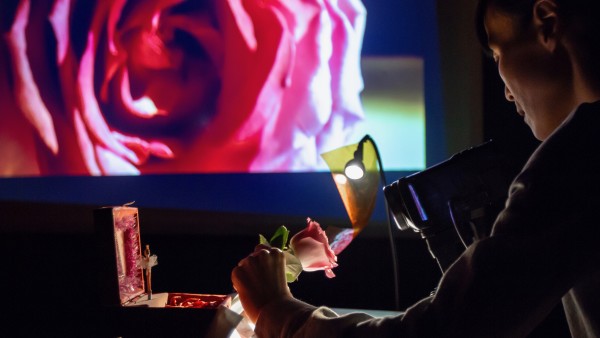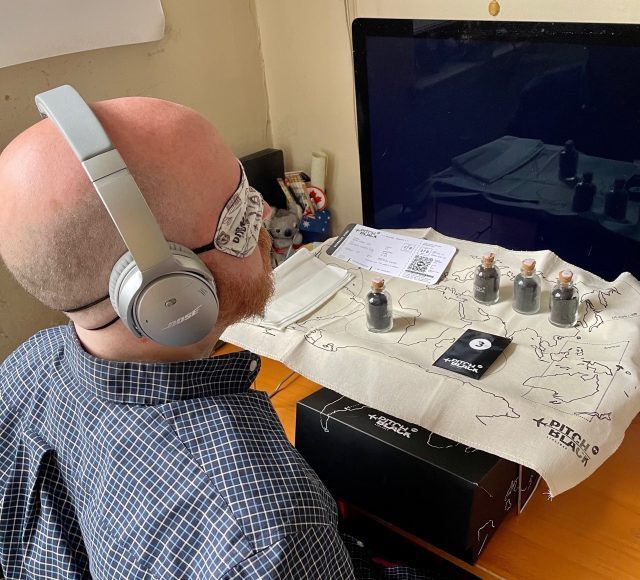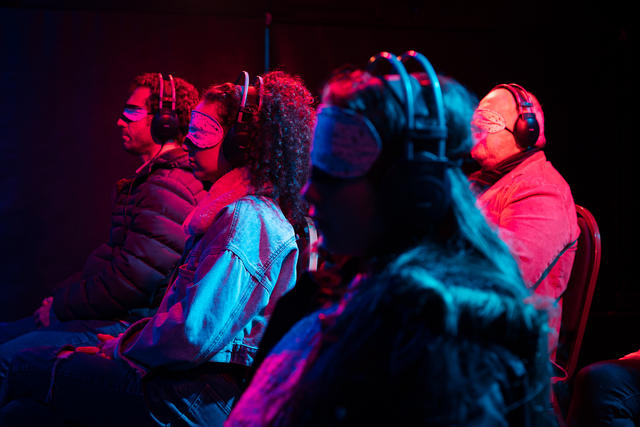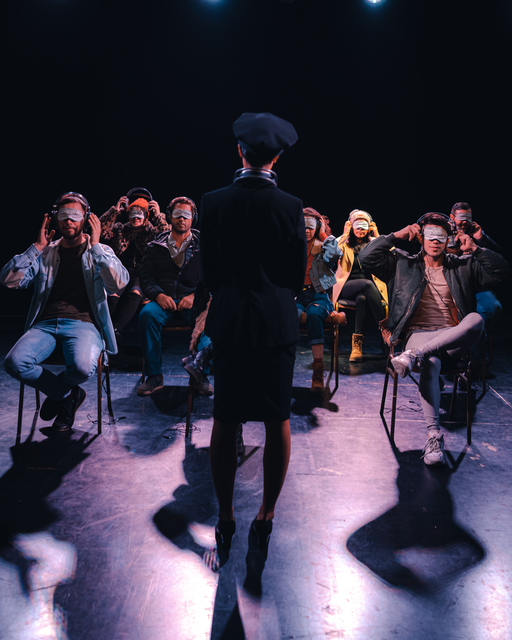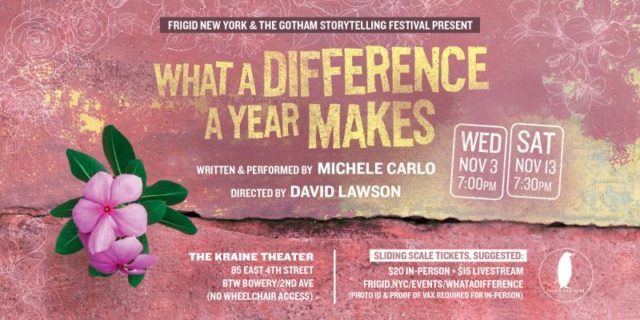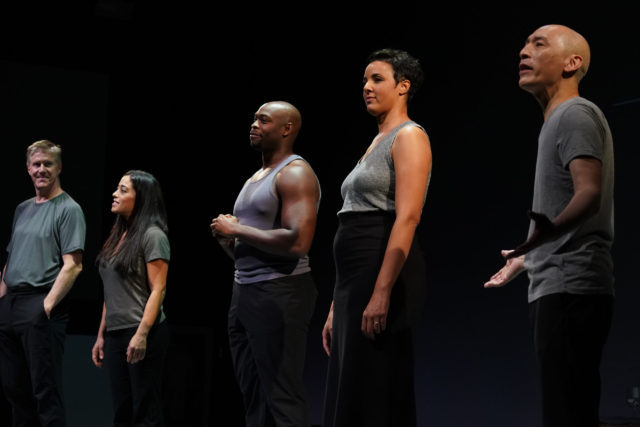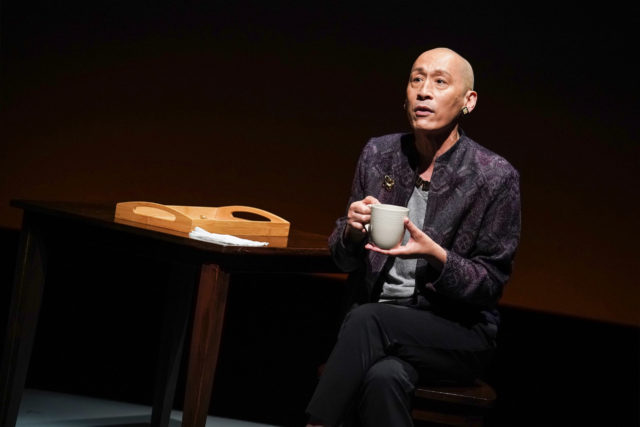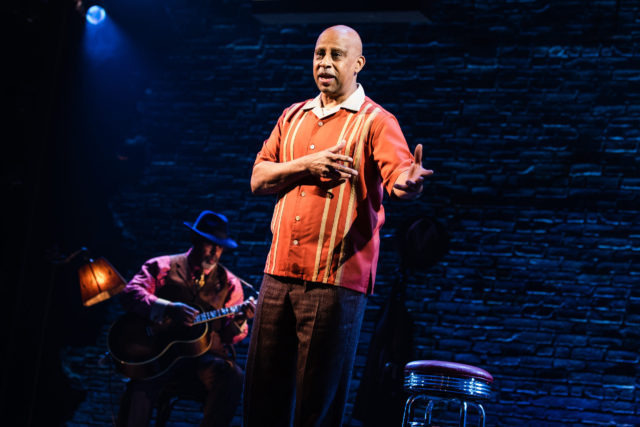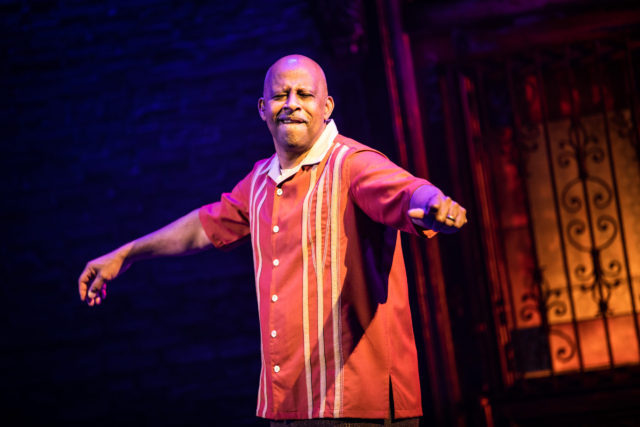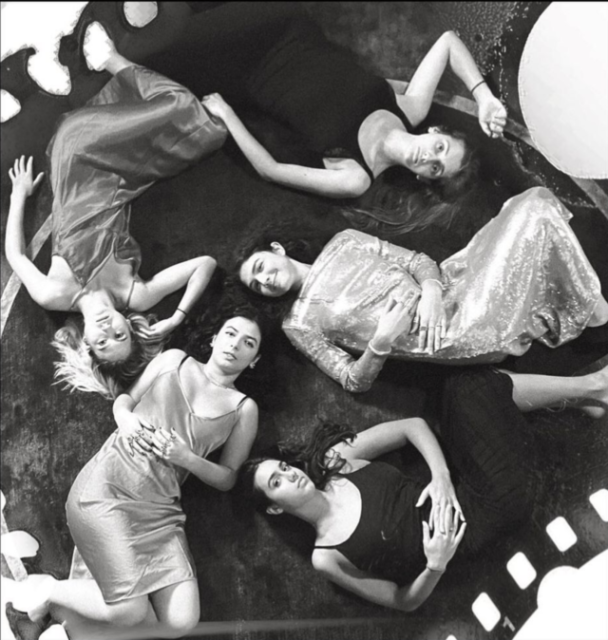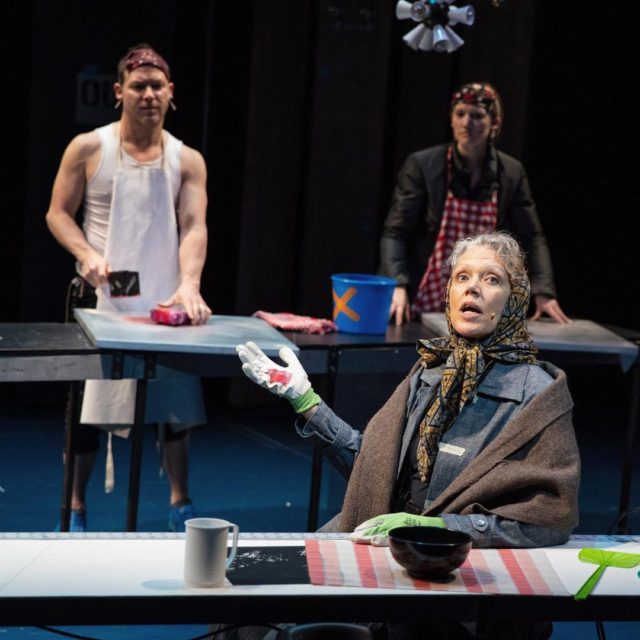
Pelagea Vlasov (Kate Valk) has some qualms with the butcher (Ari Fliakos) and his wife (Erin Mullin) in The Mother (photo by Nurith Wagner-Strauss / Wiener Festwochen)
THE MOTHER
The Wooster Group
The Performing Garage
33 Wooster St. between Grand & Broome Sts.
Tuesday – Saturday through November 20, $40
Return engagement: February 18 – March 19, $30-$40
thewoostergroup.org
It’s hard to believe that in its nearly half-century existence, the Wooster Group has never before presented a work by Bertolt Brecht, the German modernist whose revolutionary ideas about theater appear to be right in line with the experimental Soho company’s vision. So it’s exciting not only that the Wooster Group is now tackling Brecht’s seldom-performed 1932 play, The Mother, but has done such a fine job with it.
Not to be confused with Brecht’s more well known anti-Fascist Mother Courage, The Mother is one of Brecht’s Lehrstücke, a learning play meant to bring the actors and the audience together while also taking a social stand. “The aim was to teach certain forms of political struggle to the audience,” Brecht wrote in 1933 about the show when it was at the Schriften zum Theater. “It was addressed mainly to women. About fifteen thousand Berlin working-class women saw the play, which was a demonstration of methods of illegal revolutionary struggle.”
Based on Maxim Gorky’s 1906 novel, the play is built around the simple and illiterate Pelagea Vlasov (Kate Valk), who just wants to make tea and soup and protect her son, Pavel (Gareth Hobbs), who recently had his pay cut by a nickel an hour. “Me, I’m no help to him anymore,” she says. “I’m a burden.”
Pavel is involved with a pair of radicals, Semjon (Ari Fliakos) and Masha (Erin Mullin), who are illegally handing out leaflets calling for a strike against the powerful Suklinov factory. They are assisted by a teacher named Fyodor (Jim Fletcher) who doesn’t believe that their actions will lead to any viable change.
“Like the crow in the snowstorm, feeding her baby, she can’t feed her, what does she do? No way out, no way out. And crows are the smartest animal in the world, after humans,” the teacher talk-sings. “Whatever you do / It won’t be sufficient. / The situation’s bad / It gets worse. / It can’t go on like this / But what is the way out?”

The Wooster Group rehearses its unique interpretation of Bertolt Brecht’s The Mother (photo by Erin Mullin)
When she discovers what Pavel is up to, Pelagea turns courageous, demanding to hand out the leaflets herself so her son can be safe. A policeman (Fletcher) starts sniffing around, so Pelagea moves in with the teacher, who is not thrilled that his calm life has suddenly been upended. After the workers’ representative, Karpov (Fliakos), returns with an unsatisfactory deal, the revolutionaries sing, “Good, this is the breadcrumb / Ah, but where is / The whole loaf?” Events get ever-more dangerous as Pelagea takes up the cause, praising Communism, while the police, factory sympathizers, and strikebreakers loom in every corner.
In true Wooster Group style, The Mother is wildly unpredictable, hysterically funny, and emotionally poignant, winding itself in and out of Brecht’s words. Addressing the audience following the song “Praise of Communism,” the teacher explains about Brecht, “You know, for somebody who says he doesn’t want emotions in the theater, there’s a lot of emotion in that song, you know — it’s the end of madness, it’s the end of crime, is that not sentimental?” Props are smashed and then replaced. Projections by Irfan Brkovic on the back wall and a monitor focus on the factory town and a rallying flag, with original music by Amir ElSaffar.
The set, built by Joseph Silovsky, consists of a long table where the characters often sit, interacting with a laptop and the script itself; a small room where Pelagea worries about her son; a clothesline used for multiple purposes; a chalkboard where Fyodor writes important words; two doors that are labeled “Way” and “Out,” a sly reference to the song “The Question of the Way Out”; and a keyboard played by Pavel. There’s also a monitor above the audience that shows old crime movies, dictating the pace and enhancing the themes for the performers. Cofounding artistic director Elizabeth LeCompte ably brings those disparate elements together through eighty tense minutes and eleven scenes, including “What can a mother do?,” “The Mother gets a lesson in economics,” and “The war is here.”
WG founding member Valk and Fletcher (the teacher, the policeman, the prison guard, a strikebreaker) are always a joy to watch, and they lead the way in this stellar production. Fliakos (Semjon, Karpov, the gatekeeper, jobless Gorski, Vasil the butcher) and Mullin (Masha, the butcher’s wife, the Bible lady) stand right with them through minor costume changes and musical breaks. No one portrays the worker Smilgin because, as the narrator explains, they didn’t have enough money in the bank.
Speaking of money, LeCompte points out in a program note that a “spirit of repurposing” guided the show. “Nearly everything in the production has been repurposed from previous Wooster Group works. This includes performers, ideas, set elements, and all but two props: the aqua typewriter and yellow telephone. In addition to Brecht and Gorky, the company used such sources as educational media (PeeWee’s Playhouse, Kukla, Fran, and Ollie), Slavoj Žižek’s YouTube videos, the 1958 German version for the Berliner Ensemble, Rainer Werner Fassbinder’s Mother Küsters Goes to Heaven, Quentin Tarantino’s Once Upon a Time in Hollywood, books by and about Brecht, and 1930s gangster movies on TCM.
Continuing at the Performing Garage through November 20 (the show is back for a return engagement February 18 – March 19), The Mother was initially supposed to premiere in 2020, but the group took advantage of the additional pandemic downtime by continuing to work on it. (It debuted in June 2021 at Vienna’s Wiener Festwochen.) During the lockdown, I watched several videos Wooster posted about their progress, and their process, not all of which made the final cut — if a production like this can ever be called final. The script has a warning that “it may contain text that no longer appears or has been changed, and it may lack text that has been added for a given performance.”
Just as Brecht, in writing The Mother, was teaching about political struggle and theatrical form (he called the play “a piece of anti-metaphysical, materialistic, non-Aristotelian drama — that is, dramatically seen, of a very highly developed type”), the Wooster Group is teaching political struggle and Brecht himself to the audience, which is seated on mats on risers, with no backs. It’s been done previously as a melodrama, a call to action, and a politically driven full-on musical, but the Wooster Group has made it into something else entirely.
